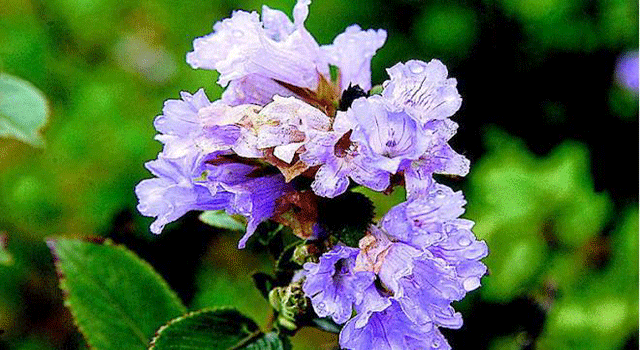
Can you imagine that a flower is used as reference in the calculation of the age in the Paliyan tribal people living in Tamil Nadu. Interestingly, the flower blossoms once in 12 years. It is no ordinary flower. About 46 varieties of this flower have been identified in India. However, all over the world there are about 240 varieties. In India, they are primarily found in South India. It is mainly found in the Western Ghats of Tamil Nadu and Kerala in places, including Ooty and Munnar. It is common there and when this flower blooms the entire hills turn bluish purple.
The Western Ghats. Nilgiri Hills, which literally means the blue mountains, got their name from the purplish blue flowers of Neelakurinji.
Use YouTube for more interest: https://www.youtube.com/watch?v=96NrkLMFOFQ
Thus, after the 2006 flowering, another mass flowering can be expected to take place near Munnar in 2014-- there is a group of plants in the locality whose flowering cycle is four years ahead of the rest of the community in the region. However, one could not be sure whether these plants would survive for the next season. The next massive flowering in the Nilgiris-Palanis-Munnar belt is expected only in this year, i.e. 2018.
In August 2008, a group of plants at Thalakkulam, about 35 km from Munnar, flowered on a hill by the side of the Kochi-Madurai National Highway. The next flowering here will be in 2020 if the seedlings survive the onslaught of human interference.

Stray flowerings of kurinji do occur annually towards the end of the 12-year flowering cycle. A few plants here and there may throw up an inflorescence while the other plants remain without flowers.
What triggers the massive flowering every 12 years is not known. However, here is an explanation for why they flower only once in 12 years. Gregarious flowering of kurinji has been documented for 180 years. The first records of ten consecutive flowerings from 1826 to 1934 were published in the Journal of the Bombay Natural History Society (1936, Vol. 38) by M. E. Robinson. However, references in the Tamil Sangham literature (200 B. C.-300 A. D.) suggest that kurinji used to flower for hundreds of years.
Of all long interval bloomers (or plietesials) Strobilanthes kunthianus is the most rigorously demonstrated, with documented bloomings in 1838, 1850, 1862, 1874, 1886, 1898, 1910, 1922, 1934, 1946, 1958, 1970 [1] 1982, 1994, 2006 and 2018.
Tamil poems dating back more than 2,000 years praise the karungal kurinji and the honey made from bees that feed on its nectar. Hindu mythology records god Murugan wearing a garland of the flowers at his wedding to a local girl. Hordes of tourists drive to Ooty, in particular, to witness the rare sight.
Kurinji grows at an altitude of 1300 to 2400 metres. The plant is usually 30 to 60 cm high. They can, however, grow well beyond 180 cm under congenial conditions.

Most of these species show an unusual flowering behavior, varying from annual to 16-year blooming cycles.
Plants that bloom at long intervals like Strobilanthes kunthianus are known asplietesials. Other commonly used expressions or terms which apply to part or all of the plietesial life history include gregarious flowering, mast seeding and supra-annual synchronized semelparity (semelparity = monocarpy).
Gregarious flowering of Neelakurinji (Strobilanthes Kunthiana) takes place once in 12 years between July and December. The peak season will be between August and September. Local variations are possible. (It flowers earlier in some areas of Kodaikanal.) However, the flowering cycle for a particular species remains the same, but for variations of a few months triggered possibly by local weather.
The interested to see the flowers in Munnar, Kerala may register their name with the Krishi Jagran from today till end of September 2018. The interested can visit Kerala in a group.The details shall be sent to them by WhatsApp Group and the emails. Write your interest with your name, Number of person, Age, Gender and the Profession for flowering tourism with Krishi Jagran.















